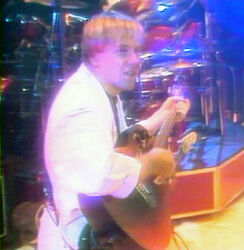The good news is that after thirty two years of a great marriage, I still fit the tuxedo I was married in. Fit, is a good thing, especially appreciated by my wife.
The "not so good news" is that being a guitar service and custom build shop, I constantly see folks playing guitars that "don't fit". Most times it's not intentional but here are a few classic examples of "guitar fit' challenges.
a. The guitar was inherited or bought as a a gift and was too large or too small for the players age or build.
b.The model, style or condition was not suitable or effective to learn on.
Good Fit is Essential!
In one particular case, a new guitar student came to me with a deep bodied, full size dreadnaught acoustic which, by all good intentions, was a surprise gift from mom and dad. Purchasing a guitar for anyone must include the players presence in order to really evaluate the fit.
Because of my student's body shape, she could not keep it in players position and short arms labored to hold the guitar properly. This guitar became a challenge to hold and thus difficult to play. I went to my closet and pulled out a parlor guitar and it fit the players needs immediately. (Parlor guitars are smaller than standard acoustic guitars). As a result, the improved relationship between the players size and guitar made the ability to learn a pleasurable experience and energized the student with confidence.
I sometimes wonder if the person or store that they purchased it even asked about the physical elements pertaining to fit for the student/player. It is a simple oversight but I wished I had a dollar for every pair of shoes I bought online that did not fit. You have to "try on" personal items and the guitar is no exception.
Though many factors enter into the choice of guitar, we at BornAgainGuitars start with fit. Other features of the guitar also become rudimentary such as neck width and radius, gauge of strings, action and body shape.
Let's start with hand size and finger length. Most steel string guitars have a 1-5/8" or 1-7/8" wide nut, ( the base point of the instrument scale where strings come from the tuning machines ) and this is the general spec that most players are familiar with. Nylon string classical guitars usually have a 2" wide nut for a different string spacing and playing style.
Importance here is to match hand size to neck style and size for ease in learning to play the instrument.
 |
| 1 3/4"nut |
 |
| Classical nut |
When choosing a "student" guitar it may be helpful to know that economy priced guitars have improved over the years but many do have somewhat high "actions" ( height of the strings from the fretboard ), that are difficult to press down causing discomfort to the new players fingers.
High humidity can also compound the situation even more. ( Acoustic guitars live well in controlled environments the likes of 68-70 degrees F with 45-55% relative humidity.)
Born Again Guitars offers customers free consultation on care and maintenance.
Finally, guitars may require additional attention to other facets such as neck alignment, truss rod adjustment, saddle / bridge, nut and fret condition, to name just a few. In most cases, these are the fixable parts of the fit and feel process...finessing your goals.
One "Fit Scenario" I recall, was with a friend who wanted to learn to play guitar. He was a brauny 6' 4" man with considerably large hands and fingers. The 1 5/8" wide nut was not at all compatible with the hand size. 1 3/4" was also tight...then 1 3/4" ...still no go.
I suggested a classical model with a 2" wide nut and it was, to quote, not his "preference".
I thought about it and then had an another idea. He had mentioned he liked to listen to Django Reinhardt albums. We immediately started looking at Gypsy Jazz guitars and "Boom!" that was the answer. I found a 2 1/8" wide nut model and it all came together.
He now has a guitar that fits and he is enjoying it a lot.
 |
| Gypsy Jazz |
At BornAgainGuitars, we see a lot of guitars and we know the importance of "Fit and Feel".
Using myself as an example...
I'm 5'8" tall with average sized hands but short fingers and short arms. I grew up with strats and teles...they seemed to fit my hand. I played standard dreadnaught style acoustics. They also "seemed" comfy.
Over the years my tastes changed and I started to consider trying different guitars. Classicals, Jumbos, semi-hollow, different basses too. What a wonderful adventure...and the word "Fit" took on new dimensions. I discovered OM style and Parlor guitars which quickly took a firm hold on me and I still prefer them to this day. I could play them better and with more versatility and expression. I prefer 1 3/4" with a 12-14" radius.
I also experienced different gauged strings and new radius configurations which opened up all types of new doors and musical genres and most importantly, it's helped me to pass that knowledge on to other up and coming guitarists...(and change the mind of a few "diehards" too.)
The bottom line is "Fit & feel"...it can go a long way so let BornAgainGuitars help you find that perfect fit, improve your playing and make your musical journey an exciting, comfortable and rewarding one.
Call us at 919-906-0318 and remember...
"Stay Tuned!"






